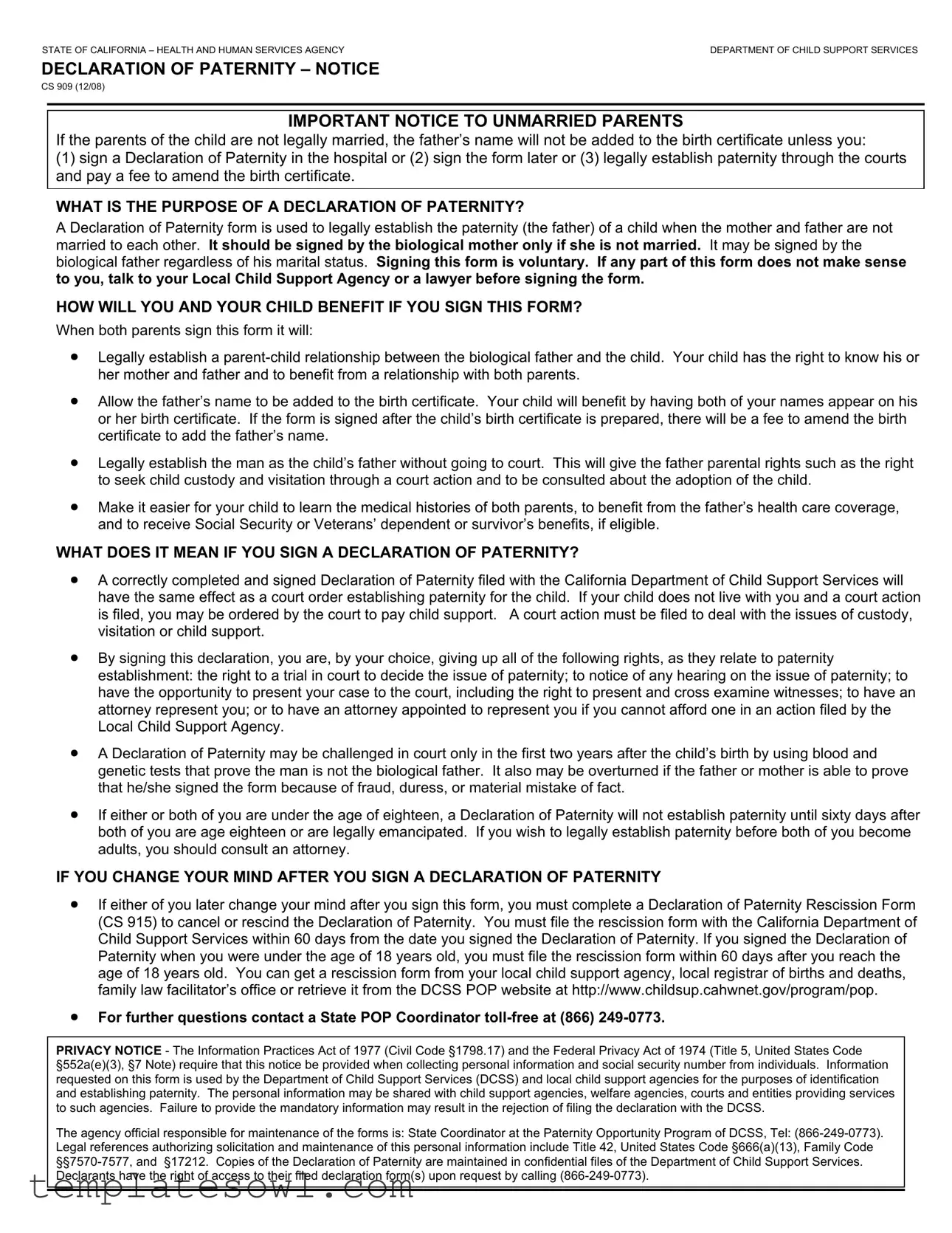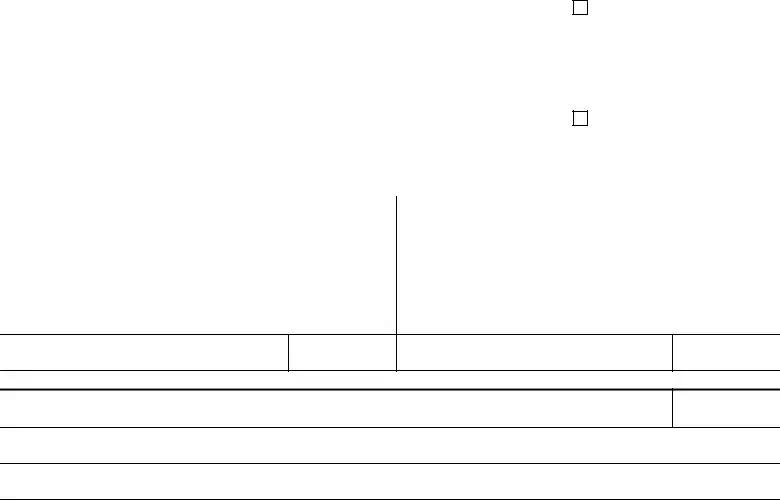STATE OF CALIFORNIA – HEALTH AND HUMAN SERVICES AGENCY |
DEPARTMENT OF CHILD SUPPORT SERVICES |
DECLARATION OF PATERNITY – NOTICE
CS 909 (12/08)
IMPORTANT NOTICE TO UNMARRIED PARENTS
If the parents of the child are not legally married, the father’s name will not be added to the birth certificate unless you:
(1)sign a Declaration of Paternity in the hospital or (2) sign the form later or (3) legally establish paternity through the courts and pay a fee to amend the birth certificate.
WHAT IS THE PURPOSE OF A DECLARATION OF PATERNITY?
A Declaration of Paternity form is used to legally establish the paternity (the father) of a child when the mother and father are not married to each other. It should be signed by the biological mother only if she is not married. It may be signed by the biological father regardless of his marital status. Signing this form is voluntary. If any part of this form does not make sense to you, talk to your Local Child Support Agency or a lawyer before signing the form.
HOW WILL YOU AND YOUR CHILD BENEFIT IF YOU SIGN THIS FORM?
When both parents sign this form it will:
•Legally establish a parent-child relationship between the biological father and the child. Your child has the right to know his or her mother and father and to benefit from a relationship with both parents.
•Allow the father’s name to be added to the birth certificate. Your child will benefit by having both of your names appear on his or her birth certificate. If the form is signed after the child’s birth certificate is prepared, there will be a fee to amend the birth certificate to add the father’s name.
•Legally establish the man as the child’s father without going to court. This will give the father parental rights such as the right to seek child custody and visitation through a court action and to be consulted about the adoption of the child.
•Make it easier for your child to learn the medical histories of both parents, to benefit from the father’s health care coverage, and to receive Social Security or Veterans’ dependent or survivor’s benefits, if eligible.
WHAT DOES IT MEAN IF YOU SIGN A DECLARATION OF PATERNITY?
•A correctly completed and signed Declaration of Paternity filed with the California Department of Child Support Services will have the same effect as a court order establishing paternity for the child. If your child does not live with you and a court action is filed, you may be ordered by the court to pay child support. A court action must be filed to deal with the issues of custody, visitation or child support.
•By signing this declaration, you are, by your choice, giving up all of the following rights, as they relate to paternity establishment: the right to a trial in court to decide the issue of paternity; to notice of any hearing on the issue of paternity; to have the opportunity to present your case to the court, including the right to present and cross examine witnesses; to have an attorney represent you; or to have an attorney appointed to represent you if you cannot afford one in an action filed by the Local Child Support Agency.
•A Declaration of Paternity may be challenged in court only in the first two years after the child’s birth by using blood and genetic tests that prove the man is not the biological father. It also may be overturned if the father or mother is able to prove that he/she signed the form because of fraud, duress, or material mistake of fact.
•If either or both of you are under the age of eighteen, a Declaration of Paternity will not establish paternity until sixty days after both of you are age eighteen or are legally emancipated. If you wish to legally establish paternity before both of you become adults, you should consult an attorney.
IF YOU CHANGE YOUR MIND AFTER YOU SIGN A DECLARATION OF PATERNITY
•If either of you later change your mind after you sign this form, you must complete a Declaration of Paternity Rescission Form (CS 915) to cancel or rescind the Declaration of Paternity. You must file the rescission form with the California Department of Child Support Services within 60 days from the date you signed the Declaration of Paternity. If you signed the Declaration of Paternity when you were under the age of 18 years old, you must file the rescission form within 60 days after you reach the age of 18 years old. You can get a rescission form from your local child support agency, local registrar of births and deaths, family law facilitator’s office or retrieve it from the DCSS POP website at http://www.childsup.cahwnet.gov/program/pop.
•For further questions contact a State POP Coordinator toll-free at (866) 249-0773.
PRIVACY NOTICE - The Information Practices Act of 1977 (Civil Code §1798.17) and the Federal Privacy Act of 1974 (Title 5, United States Code §552a(e)(3), §7 Note) require that this notice be provided when collecting personal information and social security number from individuals. Information requested on this form is used by the Department of Child Support Services (DCSS) and local child support agencies for the purposes of identification and establishing paternity. The personal information may be shared with child support agencies, welfare agencies, courts and entities providing services to such agencies. Failure to provide the mandatory information may result in the rejection of filing the declaration with the DCSS.
The agency official responsible for maintenance of the forms is: State Coordinator at the Paternity Opportunity Program of DCSS, Tel: (866-249-0773). Legal references authorizing solicitation and maintenance of this personal information include Title 42, United States Code §666(a)(13), Family Code §§7570-7577, and §17212. Copies of the Declaration of Paternity are maintained in confidential files of the Department of Child Support Services. Declarants have the right of access to their filed declaration form(s) upon request by calling (866-249-0773).
STATE OF CALIFORNIA – HEALTH AND HUMAN SERVICES AGENCY |
DEPARTMENT OF CHILD SUPPORT SERVICES |
DECLARATION OF PATERNITY – INSTRUCTIONS FOR COMPLETION COVERSHEET
CS 909 (12/08)
THIS FORM IS TO BE COMPLETED ONLY WHEN THE MOTHER IS UNMARRIED.
GENERAL INFORMATION
SECTION A
SECTION B
SECTION C
SECTION D
FILING THIS FORM
CANCELING OR RESCINDING THIS FORM
The attached declaration form is to be used by unmarried parents to declare the father of the child. Paternity means legal fatherhood. Completing and signing this form is voluntary. THIS IS A LEGAL
DOCUMENT. PLEASE CAREFULLY READ THE REVERSE SIDE OF THE FORM BEFORE YOU SIGN IT; there is important information about what it means to you and your child when you sign this form. IN ORDER FOR THE DECLARATION OF PATERNITY TO BE FILED, BOTH PARENTS SHALL COMPLETE ALL PORTIONS OF SECTIONS A AND B AND SIGN THIS FORM. The form must be signed in the presence of a witness from the hospital or agency accepting the form. If not signed at a hospital, prenatal clinic or public agency, you must sign the form in the presence of a Notary Public. If you are the biological father and you wish to have your name entered on the child’s birth certificate, you must sign this form. Otherwise, you must go to court to establish legal paternity and pay a fee to amend the child’s birth certificate to add you name. Please see section “Filing This Form” below for more details.
PLEASE USE BLACK OR BLUE INK WHEN FILLING OUT THE ATTACHED FORM. PRINT ALL INFORMATION, EXCEPT FOR YOUR SIGNATURE. PLEASE PRESS FIRMLY AND PRINT CLEARLY WHEN FILLING OUT THE FORM. THIS FORM MUST BE SIGNED IN THE PRESENCE OF AN AUTHORIZED REPRESENTATIVE OR A NOTARY PUBLIC.
All portions of this section must be completed. This section identifies the mother, biological father, child and the place of the child’s birth. Your social security number may be used so child support, and other benefits your child may need, may be collected. If you write down your social security number, it will be on any copies made of this form. If you don’t have a social security number, you must check the box indicating that you do not have one. Failure to provide a social security number or check the box indicating you do not have one, may result in your declaration not being filed and returned to you.
In this section, both parents declare they are the mother and biological father of the child named on this form. Both parents must sign and date the form, for this form to be legal. PLEASE READ THE
REVERSE SIDE OF THE FORM BEFORE YOU SIGN IT.
This section is to be completed by the person who is a witness to the parents’ signatures on the form. The witness must be an official representative of the hospital or agency accepting the form.
This section is to be completed ONLY when the form is witnessed by a Notary Public. If parents do not complete the form at a hospital, prenatal clinic or public agency, they can only sign it before a Notary Public. This section is to be completed, signed and stamped by a Notary Public.
The original of this form MUST be sent to:
Department of Child Support Services
Paternity Opportunity Program (POP)
P.O. Box 419070
Rancho Cordova, CA 95741-9070
THE ORIGINAL OF THIS FORM MUST BE SENT WITHIN 20 DAYS OF THE DATE IT WAS SIGNED.
If you did not complete this form at the hospital (or when you registered your child’s birth), and you want to add the father’s name to the birth certificate, you must contact the California Department of Public Health, Office of Vital Records, MS 5103, PO Box 997410, Sacramento, CA 95899-7410 or your local Registrar of Births and Deaths. They will provide you with the additional forms you need to complete. You will be charged a fee to have your child’s birth certificate changed to include the father’s name. Both parents will be given a copy of this form. This form is an important legal record.
To rescind or cancel this form, either parent must complete and sign a Declaration of Paternity Rescission (CS 915). This form must be filed with the California Department of Child Support Services POP Unit (see address above) within sixty days of the date the paternity declaration was signed. If you signed the Declaration of Paternity when you were under the age of 18 years old, you must file the rescission form within 60 days after you reach the age of 18 years old. To obtain a form to rescind or cancel this form, contact the local child support agency, local registrar of births and deaths, or family law facilitator’s office or retrieve it from the DCSS POP website at http://www.childsup.cahwnet.gov/program/pop/. Evidence that a copy of the form has been provided to the other parent must also be provided with the rescission form. Rescinding this form will not remove the father’s name from the birth certificate.
SIGNATURE OF FATHER
STATE OF CALIFORNIA – HEALTH AND HUMAN SERVICES AGENCY |
|
|
|
|
|
DEPARTMENT OF CHILD SUPPORT SERVICES |
DECLARATION OF PATERNITY |
|
SEND ORIGINAL (White Copy) TO: DCSS – Paternity Opportunity Program |
CS 909 (12/08) |
|
|
|
|
|
|
PO Box 419070 |
INSTRUCTIONS: PLEASE READ PAGE 1 AND 2 BEFORE COMPLETING |
|
Rancho Cordova, CA 95741-9070 |
|
|
|
|
|
|
|
|
|
|
SECTION A |
ALL PARTS OF SECTIONS A & B SHALL BE COMPLETED AND EITHER SECTION C OR D WITNESSED |
|
CHANGES CANNOT BE MADE TO THIS FORM ONCE IT IS FILED WITH THE STATE |
|
|
|
NAME OF CHILD – FIRST |
|
MIDDLE |
|
|
LAST |
Child |
|
|
|
|
|
|
|
DATE OF BIRTH (Month, Day, Year) |
|
SEX |
|
|
|
|
|
|
|
|
|
|
|
|
|
HOSPITAL NAME |
|
|
|
|
CITY |
Place of |
|
|
|
|
|
|
|
Birth |
|
|
|
|
|
|
|
COUNTY |
|
STATE |
|
|
|
|
|
|
|
|
|
|
|
|
|
NAME OF FATHER – FIRST |
|
MIDDLE |
|
|
|
LAST |
Father’s |
|
|
|
|
|
DATE OF BIRTH (Month, Day, Year) |
|
SOCIAL SECURITY NO. (See Privacy Notice on back of this page) |
|
BY CHECKING THIS BOX I CERTIFY I DO NOT |
Information |
|
|
|
|
|
|
|
|
|
|
|
|
HAVE A SOCIAL SECURITY NUMBER |
|
|
|
|
|
|
|
|
CURRENT ADDRESS (NUMBER, STREET, CITY, STATE, ZIP) |
|
|
|
|
|
|
|
|
|
|
|
|
|
NAME OF MOTHER – FIRST |
|
MIDDLE |
|
|
|
LAST |
Mother’s |
|
|
|
|
|
DATE OF BIRTH (Month, Day, Year) |
|
SOCIAL SECURITY NO. (See Privacy Notice on back of this page) |
|
BY CHECKING THIS BOX I CERTIFY I DO NOT |
Information |
|
|
|
|
|
|
|
|
|
|
|
|
HAVE A SOCIAL SECURITY NUMBER |
|
|
|
|
|
|
|
|
CURRENT ADDRESS (NUMBER, STREET, CITY, STATE, ZIP) |
|
|
|
|
|
|
|
|
|
|
|
|
SECTION B READ OTHER SIDE BEFORE SIGNING |
|
|
|
|
|
|
|
|
I declare under the penalty of perjury under the laws of the State of California |
I declare under the penalty of perjury under the laws of the State of California |
that I am the biological father of the child named on this declaration and that the |
that I am the unmarried natural mother of the child named on this |
information I have provided is true and correct. I have read and understand the |
declaration and that the information I have provided is true and correct. I |
rights and responsibilities described on the back of this form. |
I understand that |
have read and understand the rights and responsibilities described on the |
|
SAMPLE |
by signing this form I am consenting to the establishment of paternity, thereby |
back of this form. I certify that the man signing this form is the only possible |
waiving those rights. I am assuming all of the rights and responsibilities as the |
father of this child. I know that by signing this form I am establishing the man |
biological father of this child. I wish to be named as the father on the child’s birth |
signing this form as the biological father of this child with all the rights and |
certificate. |
|
|
|
responsibilities of a biological father under the laws of California. I consent to |
I have been orally informed of my rights and responsibilities. |
|
|
the establishment of paternity by signing this form. I have been orally |
|
|
informed of my rights and responsibilities. |
|
|
|
|
SECTION C TO BE COMPLETED BY A WITNESS AT THE HOSPITAL, AGENCY OR CLINIC (PLEASE PRINT AND SIGN)
DECLARATION WITNESSED BY (SIGNATURE AND PRINTED NAME)
NAME OF AGENCY (HOSPITAL, CLINIC OR OTHER)
CURRENT ADDRESS (NUMBER, STREET, CITY, ZIP)
SECTION D TO BE COMPLETED BY A NOTARY PUBLIC IF SECTION C IS NOT WITNESSED ABOVE
State of ______________________________________ |
County of ______________________________________ |
|
On _____________________________ before me, ____________________________________________________ |
|
(date) |
(insert name and title of the officer) |
|
Personally appeared ____________________________________________________________________________ |
|
_______________________________________________________________________________________________ |
|
who proved to me on the basis of satisfactory evidence to be the person(s) whose name(s) is/are |
|
subscribed to the within instrument and acknowledged to me that he/she/they executed the same in |
|
his/her/their authorized capacity(ies), and that by his/her/their signature(s) on the instrument the person(s) |
|
or the entity upon behalf of which the person(s) acted, executed the instrument. I certify under PENALTY |
|
OF PERJURY under the laws of the State of California that the foregoing paragraph is true and correct. |
|
WITNESS my hand and official seal. Signature____________________________________________________ |
(SEAL) |
|
|
|
|
|
|
DISTRIBUTION: Original White Copy – DCSS |
Yellow & Pink Copies – Parents |
Green Copy – Local Child Support Agency |
WHAT IS THE PURPOSE OF A DECLARATION OF PATERNITY?
A Declaration of Paternity form is used to legally establish the paternity (the father) of a child when the mother and father are not married to each other. It should be signed by the biological mother only if she is not married. It may be signed by the biological father regardless of his marital status. Signing this form is voluntary. If any part of this form does not make sense to you, talk to your Local Child Support Agency or a lawyer before signing the form.
HOW WILL YOU AND YOUR CHILD BENEFIT IF YOU SIGN THIS FORM?
When both parents sign this form it will:
•Legally establish a parent-child relationship between the biological father and the child. Your child has the right to know his or her mother and father and to benefit from a relationship with both parents.
•Allow the father’s name to be added to the birth certificate. Your child will benefit by having both of your names appear on his or her birth certificate. If the form is signed after the child’s birth certificate is prepared, there will be a fee to amend the birth certificate to add the father’s name.
•Legally establish the man as the child’s father without going to court. This will give the father parental rights such as the right to seek child custody and visitation through a court action and to be consulted about the adoption of the child.
•Make it easier for your child to learn the medical histories of both parents, to benefit from the father’s health care coverage, and to receive Social Security or Veterans’ dependent or survivor’s benefits, if eligible.
WHAT DOES IT MEAN IF YOU SIGN A DECLARATION OF PATERNITY?
•A correctly completed and signed Declaration of Paternity filed with the California Department of Child Support Services will have the same effect as a court order establishing paternity for the child. If your child does not live with you and a court action is filed, you may be ordered by the court to pay child support. A court action must be filed to deal with the issues of custody, visitation or child support.
•By signing this declaration, you are, by your choice, giving up all of the following rights, as they relate to paternity establishment: the right to a trial in court to decide the issue of paternity; to notice of any hearing on the issue of paternity; to have the opportunity to present your case to the court, including the right to present and cross examine witnesses; to have an attorney represent you; or to have an attorney appointed to represent you if you cannot afford one in an action filed by the Local Child Support Agency.
•A Declaration of Paternity may be challenged in court only in the first two years after the child’s birth by using blood and genetic tests that prove the man is not the biological father. It also may be overturned if the father or mother is able to prove that he/she signed the form because of fraud, duress, or material mistake of fact.
•If either or both of you are under the age of eighteen, a Declaration of Paternity will not establish paternity until sixty days after both of you are age eighteen or are legally emancipated. If you wish to legally establish paternity before both of you become adults, you should consult an attorney.
IF YOU CHANGE YOUR MIND AFTER YOU SIGN A DECLARATION OF PATERNITY
•If either of you later change your mind after you sign this form, you must complete a Declaration of Paternity Rescission Form (CS 915) to cancel or rescind the Declaration of Paternity. You must file the rescission form with the California Department of Child Support Services within 60 days from the date you signed the Declaration of Paternity. If you signed the Declaration of Paternity when you were under the age of 18 years old, you must file the rescission form within 60 days after you reach the age of 18 years old. You can get a rescission form from your local child support agency, local registrar of births and deaths, family law facilitator’s office or retrieve it from the DCSS POP website at http://www.childsup.cahwnet.gov/program/pop.
•For further questions contact a State POP Coordinator toll-free at (866) 249-0773.
PRIVACY NOTICE - The Information Practices Act of 1977 (Civil Code §1798.17) and the Federal Privacy Act of 1974 (Title 5, United States Code §552a(e)(3), §7 Note) require that this notice be provided when collecting personal information and social security number from individuals. Information requested on this form is used by the Department of Child Support Services (DCSS) and local child support agencies for the purposes of identification and establishing paternity. The personal information may be shared with child support agencies, welfare agencies, courts and entities providing services to such agencies. Failure to provide the mandatory information may result in the rejection of filing the declaration with the DCSS.
The agency official responsible for maintenance of the forms is: State Coordinator at the Paternity Opportunity Program of DCSS, Tel: (866-249-0773). Legal references authorizing solicitation and maintenance of this personal information include Title 42, United States Code §666(a)(13), Family Code §§7570-7577, and §17212. Copies of the Declaration of Paternity are maintained in confidential files of the Department of Child Support Services. Declarants have the right of access to their filed declaration form(s) upon request by calling (866-249-0773).




